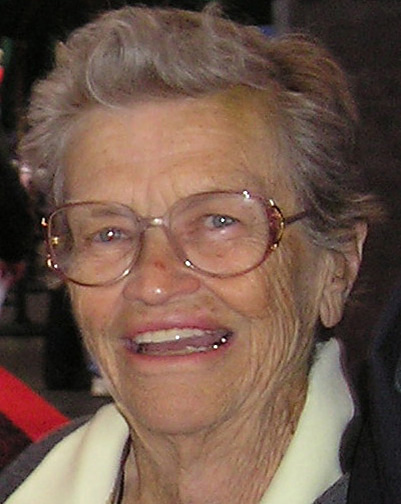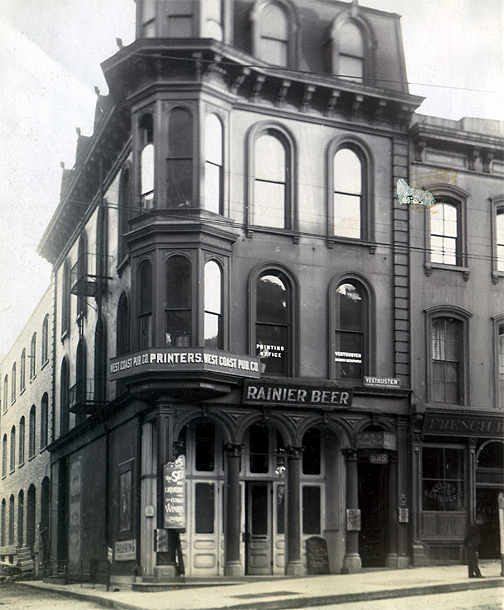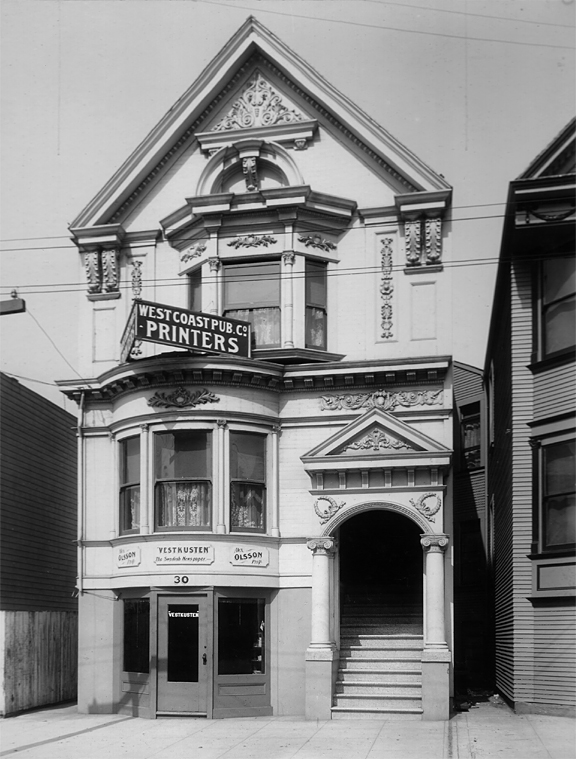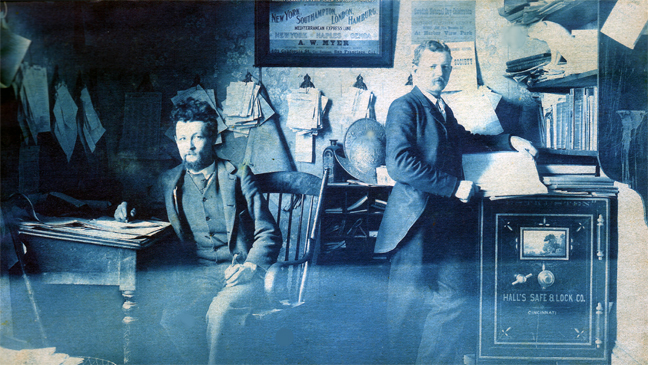From Ebenezer to Vestkusten,
to Nordstjernan. The story of San Francsico based Swedish newspaper Vestkusten, founded in 1886, merged with Nordstjernan in December, 2007.
-
 Muriel Nelson Beroza. Photo courtesy Ted Olsson.
Muriel Nelson Beroza. Photo courtesy Ted Olsson. -
-
The story of Vestkusten
There were several attempts to produce a Swedish language newspaper on the west coast starting in 1873, but none of them lasted for more than a year or so. The first successful paper was Vestkusten. It was the brainchild of Johannes Telleen. He was born in 1846 in Halland and immigrated with his parents to Moline, Illinois in 1853 at the age of 7. Eventually he attended Augustana Seminary and was ordained in 1872. After serving in several churches in the midwest he answered the call for a position as the first pastor of the Ebenezer Swedish Evangelical Lutheran Church in San Francisco in 1883. Telleen was 37 years old at the time. One of his plans was to have a Swedish language newspaper to help his parishioners settle in the new land. The primary purpose of the publication would be to carry church news, discussions of ecclesiastical subjects and other items of interest from Sweden.
The paper started with the name of Ebenezer and it was a small four-page pamphlet, published monthly. The first issue was 31 October 1886. The second was issued in November of that year. Telleen’s grand plans for a real newspaper proved to be too difficult financially and too time consuming. He turned the paper over to the editor Alrik G. Spencer, who had also been serving as the typesetter. Spencer, born in Västergötland in 1870, started his career in San Francisco by printing city directories and sheet music. The first issue under the name Vestkusten was printed in January 1887. Spencer managed the paper for four years. He expanded it and published it weekly. Some of the men who served as editors and staff members under him were Murberg, Borgström and J.A. Almqvist.
In 1891 Ernst Skarstedt was hired as the new editor. He was a well-known and respected writer of articles and books about the Swedish people in America. Skarstedt was born in 1857 at the Solberga parsonage where his father served. His father Carl Wilhelm Skarstedt was eventually appointed Professor of Theology at Lund University. Ernst received an excellent education but had no desire to follow his father’s career in the church. At the age of 18, he went to sea and eventually came to America. He was a talented violinist, a poet, a photographer, a good observer of the world around him and he had a profound understanding of the Swedish people about whom he would write. During his time at Vestkusten he raised the literary quality of the paper by translating books of literary merit into Swedish, which appeared in serial form in the paper. He also wrote articles, poems, his observations of the Swedes and the scene in San Francisco. He stayed with Vestkusten for close to six years and even continued to send articles later.
Alexander Olsson joined the paper in 1890 as typesetter and treasurer. Olsson was born in 1868 in Onsala. He had worked for the newspaper Norhalland in Kungsbacka, Sweden for four years. He learned the basics of the newspaper and printing business there before coming to San Francisco in 1889 at the age of 21. By 1894 Spencer and all of his backers were tired of waiting for some financial rewards and decided to abandon their ownership of the paper. The paper was purchased by Skarstedt and Olsson that year. With some good management techniques, they began to turn the corner and the paper became a popular source of news for the Swedish people of the area.
Skarstedt was something of a dreamer and preferred more bucolic climes than that offered by the Bay Area. He left for Oregon and Washington in 1896, and Olsson became the sole owner and publisher of Vestkusten. During their partnership they had purchased a Swedish language collection of books from the organist of the church, O.A. Classel. -
 Vestkusten Office on California Street 1902, before its destruction in 1906.
Vestkusten Office on California Street 1902, before its destruction in 1906. -
-
The Great Earthquake
The paper’s office, printing presses and book store were located at 3rd and Minna Street in 1891. They moved to 921 Mission Street in 1893 and finally to 32 California Street near the Ferry Building in 1895. This locale proved to be a disastrous one. In the early hours of 18 April 1906, first the catastrophic quake and then the firestorm soon demolished all of that area and most of downtown.
The only thing Olsson was able to save that fateful morning was the subscription list. It proved a fortunate rescue. With heroic efforts he was able to publish an issue of the paper April 26, only 8 days after the disaster with the headline “San Francisco in Ruins.” It was a bonanza for the Swedes of the area. Articles gave information concerning the whereabouts of friends, news of their well-being and information about those in need of help. All of the office equipment, the printing presses, the book store and everything else were lost during the fire storm. Olsson had to get the paper printed in Oakland and lived there for a short time. Even securing a press was difficult as the one he was able to get lacked the three extra Swedish vowels. He had to use some other signs to print the paper … but he did and the stories carried were of great interest and comfort to the Swedish colony. Within a very short time, Olsson purchased a house at 30 Sharon Street in the middle of the San Francisco Swedish Duboce Triangle neighborhood. The paper was published from this address for 22 years, the family living upstairs and the downstairs converted to offices and the printing presses. In 1928, a new office space was acquired at 253 Church Street, still happily in the middle of the Swedish neighborhood. The business involved not only the newspaper but the much more profitable West Coast Publishing Company as well. -
 Vestkusten Office on Sharon Street 1908 to 1928.
Vestkusten Office on Sharon Street 1908 to 1928. -
The remarkable Olssons
Alexander Olsson became an indispensable member of the Swedish scene … not only for his newspaper but for other activities, too. He was one of the founding members of the Swedish American Patriotic League and served as president of that group for five years. After his stint as president, he was their secretary for more than fifty years. This post was later filled by various members of his family. Olsson belonged to every Swedish organization within the city. It is remarkable that almost all the members of his family have been very involved in every aspect of the Swedish community of the Bay Area. The Swedish traditions have been held together to an astonishing degree by Alexander and his progeny, partly through the paper but also through the various organizations that have benefited from the attention of this family. Alexander Olsson was honored by three kings of Sweden with medals as a tribute to his many contributions to keep Swedish culture alive in America.
The success of the paper as a financial venture has never been very large. It is probably true that the printing press revenues helped to keep the paper afloat over the long years of its publication. When Alexander passed away in 1952, the paper was then directed by his son Hugo, who was born on 22 April 1909 in San Francisco. Hugo’s first newspaper-related adventure was a trip to Europe in 1928, when he was 19, to acquaint him with the European/Swedish scene. He also took some courses at Augustana College before plunging into the newspaper and printing business. Employees of the paper during those early days were family members brothers Gustav and John Olsson, sister Minnie Olsson, and his daughter Martha Olsson Kuhnle. Other staff members were Ida Olsson Hanson Malmquist, Sven Lundqvist, Åke Almen, Daniel Birgers, Hulda Bordin, Per Hillerström and Eric Korsgren. Hugo remained at the helm of the business until 1964 when he sold the paper to Karin Person and the printing press business to Per Hillerström. -
 Ernst Skarstedt and Alexander Olsson at the Vestkusten's earlier Office, 1895. Skarstedt, one of Swedish America’s most prolific writers spent time at Vestkusten between 1891 and 1896. In later years he became the editor of Nordstjernan, climbing the steps of the legendary office on Park Row, New York City, for six years between 1920 and 1926.
Ernst Skarstedt and Alexander Olsson at the Vestkusten's earlier Office, 1895. Skarstedt, one of Swedish America’s most prolific writers spent time at Vestkusten between 1891 and 1896. In later years he became the editor of Nordstjernan, climbing the steps of the legendary office on Park Row, New York City, for six years between 1920 and 1926. -
Enter Karin Persson in 1957
Hugo hired Karin Person in 1957 as a reporter for the paper. She worked full time at the paper as a fine writer and also did meticulous research into early day Swedes in California. Person was born in Ronneby, Blekinge in 1909 and graduated from the Poppius School of Journalism in Stockholm. She came to California and interned at California Veckoblad in Los Angeles before coming to San Francisco as a reporter for Vestkusten. She was 55 years old when she took over the paper as editor and publisher.
The finances of managing the paper were wholly dependant upon the subscription and ad revenues. It was almost impossible for her to achieve a profit. The momentous advances in the technology of printing were beyond her experience and she had difficulty finding a print shop that would handle the old fashioned method. She typed out her articles and even pasted them up which were then converted to print form. Many of the smaller firms had already switched from hot lead to the new offset method. It became very expensive for the old printing process to change to modern computer printing techniques. For her to learn the wondrous advantages of the computer age was out of the question. The financial aspects of keeping this paper afloat were getting overwhelming.
Friends of Vestkusten
As she was about to discontinue the paper, a group of Swedish supporters began to tackle the problem of helping her with equipment and additional funds for her survival. At first it was the support of individual members of the Swedish American Chamber of Commerce and the Swedish Club who provided some help. The formation of the Friends of Vestkusten was an idea first generated by Lisa Wiborg. She got a group together to meet and discuss ways in which they could help Person keep the paper going. It was a resource for the Swedish community that they did not want to see disappear.
Many of the members of the Swedish Colony in the Bay Area decided it was time to offer some new ideas and citizen support to keep the paper in print. In 1973 a meeting was held at the Swedish Consular office on Jackson Street. Hans Sköld was Consul General and hosted the meeting. A new committee of concerned Swedes was formed, called Friends of Vestkusten, with the object of raising funds to keep the paper on a good financial footing. The paper would now be issued every two weeks, tabloid size and kept to 8 pages. The Swedish government also stepped in to help ethnic papers if there was local community support for it. Vestkusten already had this in place with the organization of the Friends. All of the subsequent consuls general have hosted the special party to raise funds. A champagne reception was usually held in the spring of each year. Many meetings were held to organize and facilitate the necessary details for this large party. The only official office was that of chairman and therefore no minutes were kept except those necessary for the yearly event.
The first chairman of the Friends was Uno Lamm who served for 12 years. Lamm was a Swedish electrical engineer and inventor. He is fondly remembered as the inventor of high voltage electricity transmission, which made possible the electrification of the world. Carl Svenson, a local attorney, remained as treasurer for 12 years. Some of those involved in the early days were Lisa Wiborg, Evelyn and Hugo Olsson, Ulla Sabelström, Martha Kuhnle, Robert Peterson, Siv and Arthur Elwing, John Westermark, Bridget Stromberg-Brink, Lena Sivik, Bruce and Astri Feist, Carl Svenson, Irene Bryggman, Gladys and John Peterson, Karin Seeman, Thora Elfing, Oscar and Eva Person, Ulla Reilly, Sarah Van Zee, Anders Field and Ramona Talbot. There were many others who later joined in this effort to keep our special paper in business. Robert Peterson was heavily involved in keeping Karin Person and the paper going during her later tenure. She was listed as Editor Emeritus until her passing in 2002.
The birth of this special group was closely followed by the formation of another committee that has been instrumental in keeping Swedish traditions alive. It was the New Sweden ‘88 committee that was formed to help organize the special celebration of the 350th anniversary of the first Swedish settlement in the new world in Delaware. Honorary Consul General Siri Eliason was the spirit and motivating force behind the committee and all its celebrations. She also hosted the Friends reception at her home for many years. The New Sweden ’88 committee is still functioning, now under the name Swedish Cultural Events Committee, presided over by Ted Olsson, the grandson of Alexander Olsson. -
A New Era with Sachs-Osher
In 1991 the paper was purchased by Barbro Sachs-Osher and Sune Lundberg, and the need for financial support from the Friends of Vestkusten was no longer a factor. The Friends disbanded and their remaining funds were turned over to the Archives and Library committee at the Swedish American Hall.
Lundberg was a retired successful businessman from the furniture industry who held the dream of becoming a newspaperman. His delight in his new position as editor was short lived as he passed away within a couple of months.
The paper became owned solely by Barbro Sachs-Osher. She was born in Stockholm and graduated from Stockholm University with degrees in languages and political science. She spent time in Sweden in publishing and advertising before coming to America in 1980. Her activities are legendary and include her extraordinary linguistic skills in six different languages. She has been honored by many institutions and has received honorary degrees from Göteborg University, Gustavus Adolphus College, California College of Art, Dominican University and the University of South Maine. Osher was the founder of the San Francisco Chapter of SWEA (Swedish Women’s Educational Association) and was chosen in 2004 as their Woman of the Year. She is the recipient of the King’s Medal from the King of Sweden for her many works to keep Swedish culture flourishing. She chairs her husband’s Bernard Osher Foundation and her own Pro Suecia Foundation. In 1999 Osher was appointed Honorary Consul General of Sweden in San Francisco, having previously served in the same office in Los Angeles from 1995 to 1998.
With her many activities, she did not have time for the actual management of the paper. Fortunately she had the competent and talented staff of Bridget Stromberg-Brink as Managing Editor and Lena Sivik as Business Manager to organize and produce the now semi-monthly paper. Bridget Stromberg-Brink was born in Dalarna but spent most of her working years in Göteborg and Stockholm as a writer and project leader in advertising. She came to the United States in 1970 and worked at Butterfield Auction House before becoming an office manager for a high tech company in Silicon Valley. When Barbro acquired Vestkusten in 1991 she persuaded Bridget to come aboard and be the editor. It required a sharp learning curve which was a challenge well-met during her 17 years at the helm. She not only became managing editor, but an occasional photographer and graphic designer, too.
Lena Sivik was born in Uddevalla, Bohuslän, Sweden and came to the United States in 1964. Her major employment has been as a personal assistant to Barbro Osher. With the acquisition of Vestkusten she was soon involved in all business aspects of the paper in charge of subscriptions, advertisement, finances and generally making sure the paper deadlines were met – a remarkable feat on top of her other activities for Osher. In the past she had been active in a variety of fields including pediatric nursing, personnel relations, children’s clothing, textiles and the export-import business. One of her many achievements was as the production manager for 20 years of the world-famous Christmas pageant The Bracebridge Dinner in Yosemite every December. -
Cautious Expansion
Under this administration the paper expanded to include Swedish community news from southern California as well as the Bay Area. The name Vestkusten was truly being realized as the paper was covering the whole west coast of California. The paper has reported current events in Sweden including a sports page of Swedish athletic achievements. The activities of Swedish organizations from both southern and northern California were fully covered. Barbro Sachs-Osher had a regular column and a retired college professor Åke Sandler wrote a column until his passing in 2008.
Barbro Sachs-Osher generously gave the collection of old issues of Vestkusten, from 1887-1967, to the Archives. They are now available at the Swedish American Hall. With the donation from the Friends of Vestkusten the Archives Committee also purchased the microfilm copies of the old issues from the Royal Library in Stockholm and they are available at the San Francisco Public Library’s History Center. Later issues are now being photocopied at UC Berkeley for the city library to complete its collection of the newspaper. This microfilm archive is a valuable resource for local Swedes interested in the activities of the immigrant population of the Bay Area for the past 150 years.
On 15 November 2007 a final issue came out with the news that the paper was now being combined with the long established Swedish newspaper in New York, Nordstjernan. This newspaper has been published since 1872, even surpassing the tenure of Vestkusten. The local community in San Francisco was greatly saddened to be losing their own special pipeline to the California Swedish community. It is with regrets that we see the departure of this paper that has been such an important part of the San Francisco Bay Area Swedish community for the past 121 years. All of us loyal readers want to send heartfelt thanks to all those who labored so long and fervently to keep the paper going for such a remarkable span of years. We extend our very special thanks to the three incredible and talented ladies who kept the paper alive for the last 17 years. We hope that Nordstjernan will continue to cover the news of the Swedish people of California and we wish them well in this endeavor.
Muriel Nelson Beroza
Spring 2008 -
For a long time and even today, I dare say, there wouldn’t have been as much known about either the the Golden Gate Swedes or the venerable newspaper you just read about without the author of the article, Mrs. Muriel Nelson Beroza.
As readers of Nordstjernan will know, we have been fortunate to continue to work with Muriel Nelson Beroza on several issues pertaining to the Bay Area Swedes. It should be added that little had been known about many of the early Swedish settlers in the area before Ms. Belson Beroza’s never tiring efforts. She met and knew Alexander Olsson as a child. Her book “The Golden Gate Swedes” (2000) is a treasure for anyone with an interest in Swedish immigration to northern California. -
Ulf Mårtensson
-
-
